Hoe de iTunes-back-uplocatie te veranderen
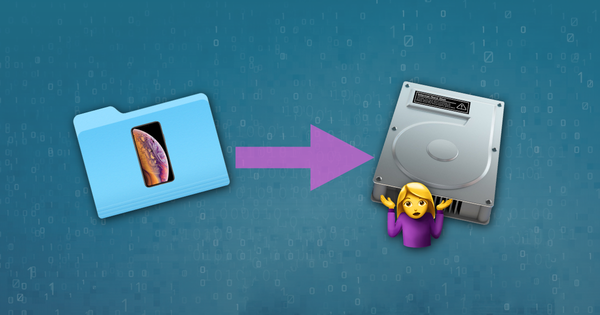
De standaard iTunes-back-uplocatie is ingesteld op de primaire schijf van de pc of Mac en in macOS 10.15 worden iOS-back-ups zoals gemaakt door Finder op dezelfde plaats opgeslagen. Veel gebruikers hebben grote back-ups of back-ups van een aantal iOS-apparaten, waardoor ze onvoldoende schijfruimte hebben.
Het is mogelijk om een computer zodanig te configureren dat iTunes een back-up maakt op een secundaire harde schijf of op een externe HDD of NAS.
Simpel gezegd, dit wordt gedaan door de iTunes back-upmap te vervangen door een symbolische link naar de gewenste locatie. Dit is een gemakkelijk omkeerbare wijziging, dus het is mogelijk om de standaardback-uplocatie terug te zetten naar de oorspronkelijke map.
Houd er rekening mee dat als de iTunes-back-uplocatie wordt gewijzigd in een volume dat niet altijd beschikbaar is, het iTunes-backupproces mislukt als de nieuwe locatie niet beschikbaar is.
Wat je nodig hebt
Om de standaard iTunes-back-uplocatie van uw computer te wijzigen, is het volgende noodzakelijk:
- Gemiddelde competentie met een pc of Mac
- 10 minuten
- Een goed begrip van het gewenste nieuwe back-uplocatiepad
- Een Mac met macOS 10.7 of nieuwer, of een pc met Windows Vista of nieuwer
- Het Reincubate-ondersteuningsteam staat voor u klaar en kan klanten adviseren hoe dit moet.
De iTunes iOS-back-upmap automatisch wijzigen
De gratis versie van iPhone Backup Extractor toont u automatisch de standaard iTunes-back-uplocatie van uw computer - en u kunt deze wijzigen.
- Download en installeer iPhone Backup Extractor .
- Kies
Preferencesin het hoofdmenu - kiezen
Backupsvan dePreferencesvenster![Het paneel "Voorkeuren" met back-uplocaties The "Preferences" pane showing backup locations]()
Het paneel "Voorkeuren" met back-uplocaties - Klik op de knop
Changeom het proces te starten van het wijzigen van uw iTunes-standaardback-upmap.
De iTunes iOS-back-upmap op Windows handmatig wijzigen
- Open the default Backup location in Explorer using the Windows Run command. Press
⊞ Win+Rand the Run window should appear. For Windows 7, 8 and Windows 10 iTunes Apple version, enter%APPDATA%\Apple Computer\MobileSyncand press⏎ Enter. For iTunes Microsoft Store version, enter\Users\[USERNAME]\Apple\MobileSync\Backup, where[USERNAME]is your Windows user name. - Het Explorer-venster dat verschijnt, toont een map met de naam "Backup". Dit bevat alle iTunes-back-ups die al op de computer aanwezig zijn. Om de locatie van de back-upmap te wijzigen, moet deze map worden hernoemd, verplaatst of verwijderd. Als voorbeeld zou men het kunnen hernoemen naar "Backup (Oud)".
- Nadat de map "Backup" is hernoemd, verplaatst of verwijderd, kan een symbolische koppeling worden gemaakt naar de gewenste back-uplocatie. Om dit te doen, moet een opdrachtvenster worden geopend. Door
⇧ Shiftingedrukt te houden en met de rechtermuisknop te klikken in het onlangs geopendeMobileSyncExplorer-venster, zullen gebruikers een menu zien met de optie "Opdrachtvenster hier openen" of "PowerShell-venster hier openen". Klik dat. - Gebruik de volgende opdracht
mklink /d Backup "[desired-new-backup-path]". Nadat deze opdracht is ingevoerd, drukt u op⏎ Enteren de wijziging is voltooid. - Nadat Windows opnieuw is opgestart, slaat iTunes zijn back-ups op de nieuwe locatie op.
De iTunes iOS-back-upmap handmatig wijzigen op macOS
- Start de macOS Terminal-toepassing. Dit is te vinden via Finder, onder
Applications / Utilities / Terminal. Als alternatief kan het worden gestart met Spotlight door op⌘ Cmd+ te drukkenen typ "Terminal" voordat u op⏎ Enterdrukt. - Instrueer de terminal om over te schakelen naar de standaard iTunes-back-
cd ~/Library/Application\ Support/MobileSyncdoorcd ~/Library/Application\ Support/MobileSyncen vervolgens op⏎ Enterdrukken. - Onthul de huidige back-upmap in Finder door
open .en druk vervolgens op⏎ Enter. - Het Finder-venster dat verschijnt, toont een map met de naam "Backup". Dit bevat alle iTunes-back-ups die al op de computer aanwezig zijn. Om de locatie van de back-upmap te wijzigen, moet deze map worden hernoemd, verplaatst of verwijderd. Als voorbeeld zou men het kunnen hernoemen naar "Backup (Oud)".
- Nadat de map "Backup" is hernoemd, verplaatst of verwijderd, kan een symbolische koppeling worden gemaakt naar de gewenste back-uplocatie. Gebruik de volgende opdracht
ln -s [desired-new-backup-path] ~/Library/Application\ Support/MobileSync/Backup. Nadat deze opdracht is ingevoerd, drukt u op⏎ Enteren de wijziging is voltooid. - Nadat de Mac opnieuw is opgestart, slaat iTunes zijn back-ups op de nieuwe locatie op.
Hoe de iTunes-reservekopiemap terug te zetten naar de oorspronkelijke locatie
Als u de bovenstaande stappen heeft ondernomen en u de wijziging wilt teruggeven, is het proces eenvoudig:
- Blader naar de iTunes-back-upmap .
- Verwijder de
Backupupsymlink die daar verschijnt. - Sleep uw oorspronkelijke
Backupupmap terug en hernoem deze indien nodig om overeen te komen met de oorspronkelijke naam.
Andere uitdagingen?
We hebben enkele gebruikers laten bereiken die hun iTunes-back-upmap al naar een andere locatie hebben verplaatst - gewoon door deze te slepen - en nu ontbreekt de noodzakelijke symlink voor iTunes om de back-up te kunnen zien.
Het is eenvoudig om dit op te lossen, en er zijn twee opties:
Sleep de map terug naar de oorspronkelijke map. Als je het bent vergeten, zou het
Backupgenoemd moeten worden en het leeft in~/Library/Application Support/MobileSync.Maak een symbolische koppeling die ernaar verwijst - op dezelfde manier als de bovenstaande instructies beschrijven. Als je in dit stadium bent, zou je een Terminal moeten openen en dit doen:
cd [location of the folder which now has "Backup" in it] ln -s Backup ~/Library/Application\ Support/MobileSync
Het zou zo simpel moeten zijn.
Zijn er situaties waarin dit niet mogelijk is?
Deze techniek werkt op elke Mac, maar werkt niet op Windows-pc's die vóór 2000 zijn gebouwd. Vóór de release van Windows 2000 gebruikte Windows standaard FAT-geformatteerde bestandssystemen en die zijn niet in staat om symlinks te maken. Elke Windows-pc die sinds die tijd is gebouwd, zal vrijwel zeker schijven in het NTFS-formaat gebruiken en deze ondersteunen symbolische koppelingen prima. Als u FAT gebruikt en probeert een koppeling te maken, ziet u mogelijk de volgende fout: Local volumes are required to complete the operation.
Gelukkig geeft Microsoft enkele instructies over het upgraden van een schijf van FAT naar NTFS . Het is een beetje meer technisch, maar het is mogelijk.
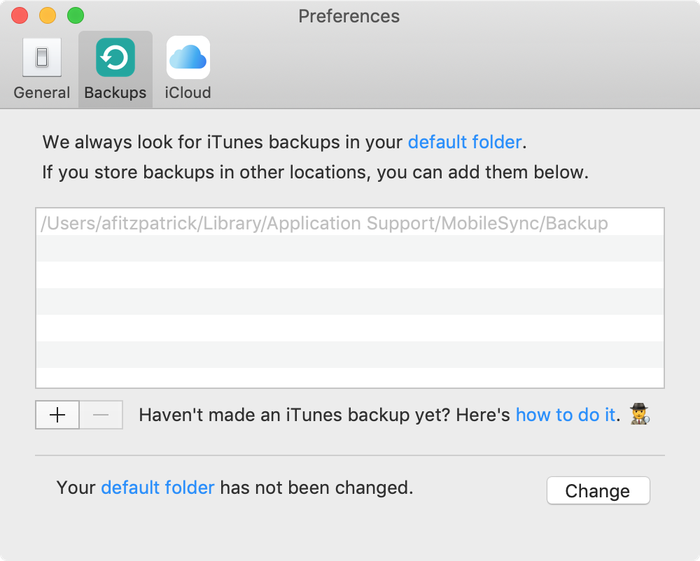
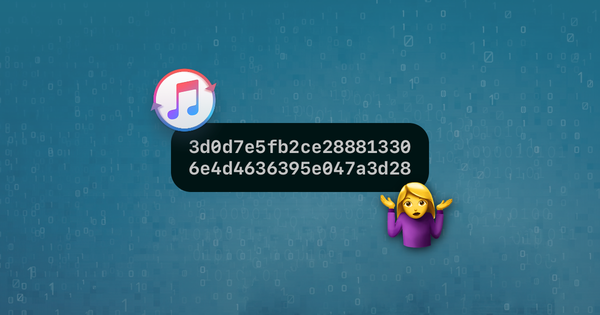

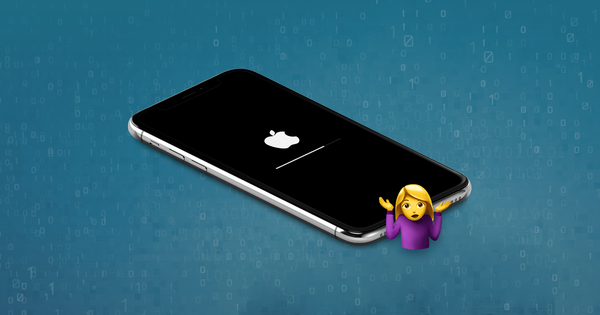
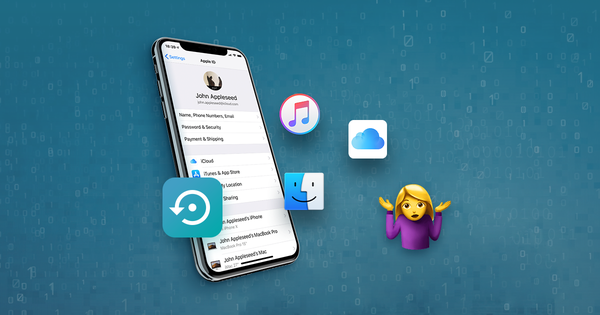

door Gael
Bonjour,
J'essaie tant bien que mal de déplacer ce Backup et de créer un lien symbolique. Cependant, la seule réponse que j'ai est: illegal option -- /
Je vous laisse le chemin que j'utilise et si une âme charitable veut bien m'aiguiller. Merci :)
ln -s/Volumes/VERBATIM\ HD/SAUVEGARDE\ IPHONE/ ~/Library/Application\ Support/MobileSync/Backup ln: illegal option -- / usage: ln [-Ffhinsv] source_file [target_file] ln [-Ffhinsv] source_file ... target_dir link source_file target_file
antwoord door: Reincubate Support
Salut Gael, merci d'avoir écrit! Le problème ici est l'espace ("") entre votre chemin et les barres obliques.
Il doit s'agir de
ln -s /Volumes/VERBATIM\ HD/SAUVEGARDE\ IPHONE/ ~ /Library/Application\ Support/MobileSync/Backup, et non deln -s / Volumes / VERBATIM \ HD / SAUVEGARDE \ IPHONE / ~ / Library / Application \ Support / MobileSync / BackupFaites-nous savoir si vous avez besoin d'aide! 🙂
door Alex
Backing up to remote Synology server (not local). All you need:
thanks
door Samuel Kwok
Exactly what I needed. I don't want to store on my MacBook as it takes 200GB. This allows me to move to a Time Capsule. I don't use Time Machine but I use Time Capsule as a network drive and another copy of the whole Time Capsule to another network drive.
antwoord door: Reincubate Support
Glad it helped!
door Rick Galloway
I've got the symbolic link created, but my iPhone back up still goes to the original C: drive location. When I look on my k: drive, I do not see the symbolic link file subdirectory even though it said it was created.
antwoord door: Reincubate Support
Hi Rick: the symlink should be in your C: drive, in
MobileSync, and calledBackups. It'd be that that points to the K: drive in your case. If you get stuck, why not use the functionality in iPhone Backup Extractor? It can do it for you, and it's in the free edition.door Colleen Gordon
How do I figure out the my desired new backup location path? I want to use an external drive.
antwoord door: Reincubate Support
Hi Colleen, thanks for commenting. If you use the functionality in iPhone Backup Extractor to change location, you can make the change simply by browsing to the folder you want. That might be easier! 🙂
door Mike L.
A fix to the insufficient permissions error--
Since I got the permissions insufficient in both cmd and powershell. First you search
cmdand then right click the command prompt app and run as admin. Navigate to the directory using the cd command ex.(cd c:\users\youruser\apple\mobilesync). once in the directory you can use the (mklink /d backup [new directory]) command listed in the article. That worked for me.As a side note, when using the cd command to navigate remember that you will likely have to put any folders with a space in the name inside quotation marks ex.(
cd c:\users\"this user"\apple\mobilesync). hopefully this helps some avoid the hassle of having to figure out this process if you get that persistent insufficient permissions response.door Aaron
Hello Aidan!
So I'm trying to change the backup path on Windows, and of course get the "insufficient privilege" error in the regular Powershell. So I ran it as administrator by typing it in the search bar and it said it created the symbolic link to the location, so I restarted my PC & tried updating iOs but the backup still went through to the original location (my hard drive, while I wanna change it to an external one simply 'cause I don't have enough space left on the former, lol).
So I guess my question is: how do I run Powershell in the MobileSync window as admin/how do I get the one I open through the search bar as admin to go to the MobileSync folder location so I can properly create the symbolic link & switch it up? :/
P.S. I did skip step one if I'm being honest, but only did so 'cause I already found the location manually, then proceeded to follow the instructions w/ renaming the folder, etc. Might this be the reason why it's not working? If so, shall I re-rename it to its original "Backup" name and try it again with the 1st step? I doubt it since I can't get the Powershell to go to the MobileSync location while I run it as admin to begin with/can't change it without running it as admin in the aforementioned window...Then again what do I know, lol.
P.P.S. Does the admin-run Powershell not need the MobileSync path to be put in and can successfully render the switcheroo by typing the featured command right after the "system32" path? If so, what seems to be the problem?
I was hoping to update my iOS tonight, and am getting more & more frustrated as we speak. Sorry for the post being so jumbled, hope all's clear. Thanks for the help!
antwoord door: Reincubate Support
Hi Aaron, thanks for the comment.
Yes, if you skipped step 1 your Powershell will be looking in the wrong folder, so it won't have created the symbolic link in the right place.
If you've already got a Powershell or command window open, you can make it change folder with this command:
cd %APPDATA%\Apple Computer\MobileSync(If it's looking at the wrong drive, you'll have to change drive by typing
C:.)We've reached out to you directly to help, but if anyone else runs into the same problem, we'd recommend undoing the steps you took, starting over, and making sure to include the first step. 🙂
door Mohamed
I tried it, the following error popped up .. Plz advise
antwoord door: Reincubate Support
Hi Mohamed, it looks like you're using PowerShell to run the command. If that's the case, you must prefix you command with
cmd /c, so it's likecmd /c mklink, etc.door Sean
I'm trying to do this on Mac OS 10.14.6 (Mohave), but when I try Step 5, I receive a "Operation Not Permitted" message. Any ideas...?
antwoord door: Reincubate Support
Hi Sean, thanks for commenting. On macOS Mojave and newer, you'll need to grant "Full Disk Access" to your Terminal in order to make the change. There's a how-to on how to do this for iPhone Backup Extractor here, I hope that helps!
door Max
Thank you for the article. Here are a few notes to help somebody.
CD(include space). Example:CD C:\Users\Username (change this)\AppData\Roaming\Apple Computer\MobileSyncmklink /d Backup "L:\Users\XYZ"door Joe
I'm still having trouble with permissions, when I open up powershell in admin I get a command line PS
C:\Windows\System32>I don't seem to be able to open it in admin mode from the file path of the itunes back up.antwoord door: Reincubate Support
Hey Joe, you can change directory using the
cdcommand. Try this:cd %APPDATA%\Apple Computer\MobileSyncdoor Jess
Thanks for this assistance! I too got stuck on the "you do not have sufficient privilege to perform this operation." I then followed your advice in the comments above and ran Powershell as an administrator, but the Powershell window that opens from the MobileSync folder doesn't seem to recognize that and keeps giving me the same message. What do I do from here? Thanks!
antwoord door: Reincubate Support
Hey Jess, thanks for writing. It's the same privilege error you're getting? If you drop us a note I'm sure we can guide you through it.
door Андрей
У меня выдает ошибку в PowerShell mklink : Имя "mklink" не распознано как имя командлета, функции, файла сценария или выполняемой программы. Проверьте правильность написания имени, а также наличие и правильность пути, после чего повторите попытку. строка:1 знак:1 + mklink /d Backup "[desired-new-backup-path]" + ~~~~~~ + CategoryInfo : ObjectNotFound: (mklink:String) [], CommandNotFoundException + FullyQualifiedErrorId : CommandNotFoundException
antwoord door: Reincubate Support
Привет Андрей, попробуй
cmd /c mklinkи так далее 🙂door Hogan
Hi Aidan, Thanks for your amazing instructions!
I have run them on my Mac but got an error saying "Library/Application Support/MobileSync/Backup: No such file or directory". I guess this happened because I have renamed the old "Backup" file. Actually, it also confuses me a lot when u say "Once the 'Backup' folder has been renamed.../Backup", as the original "Backup" file doesn't exist anymore(right?)
Looking forward to your further clarification. Thanks :)
antwoord door: Reincubate Support
Hi Hogan, thanks for your kind words. That second "Backup" reference is assuming you didn't change the folder's name, but simply moved it elsewhere. If you did rename it, you'd want to change it in that command. I hope this is clear. If it's not, do drop us a note. (Or use iPhone Backup Extractor to move it for you, as the free version can automate this process.)
door Luna
hi i get this message when i try and finalize the path: "You do not have sufficient privilege to perform this operation." It's my computer and i understand it has to do with admin rights but how do i run windows powershell as admin?
antwoord door: Reincubate Support
Hey Luna! No problem: on Windows, you'd click on the "Start" button, then type "powershell". You'll see the menu search eventually shows you the PowerShell icon. If you right-click on that, you'll see there's a "Run as Administrator" option. Good luck -- I've asked our support team to drop you an email directly in case you need further help. 🙂
door Cedric koh
If I were to delete the backup symlink in the itunes MobileSync folder,how will that affect the backup folder i used for the symlink in my other drive? Will the files inside the backup folder in my other drive be unusable?
antwoord door: Reincubate Support
Hi, thanks for stopping by. Removing the symlink is safe: it will effectively just remove the pointer to the backup folder on your other drive. The files will still be usable, but iTunes (or Finder) won't know where to look for them.
You could then move the files back to where they were originally -- or create another symlink.
door PBHRider
Great work. How do you come up with this stuff? Did the manual method on Windows 10 using the command prompt with admin privilges and am now backing up my iphones etc to my NAS drive. Saving about 4Gb on my SSD on my laptop. Thank you.
antwoord door: Reincubate Support
Really pleased it worked out for you. 👍 Don't be a stranger if you need help in future!
door Michael Milbourn
You do not have sufficient privilege to perform this operation. It's my computer, who is not letting me change things on it?
antwoord door: Reincubate Support
Michael -- if you're on a Windows machine, trying running these commands in a Windows Command that has been launched with "Run as Administrator".
door Lucas
Works like a charm! I followed the instructions for manually changing the iTunes iOS backup folder on Windows (through PowerShell). It is exactly what I was looking for to free up space on my C: drive. Thank you so much Aidan!
antwoord door: Reincubate Support
Our pleasure, we're glad it helped!
door Brad
Thank you for this
door kalveer kaur lehal
Hi thanks for this. I get an error saying:
Local volumes are required to complete the operation.
How can I fix this please? Thanks
antwoord door: Reincubate Support
Hi Kalveer, this message suggests your filesystem is FAT-based. I've updated the article to include a mention of why it's not possible to create links on FAT. I've also included a link to instructions on upgrading to NTFS. Good luck!
door Greg
Awesome instructions, thank you! I think there is a typo on step 5 for Mac. The command line is written as
-s [desired-new-backup-path] ~/Library/Application\ Support/MobileSync/Backupbut the folder "Support/MobileSync/Backup" doesn't exist since we moved/deleted it. I had to change it to "Support/MobileSync" and then the folder I linked to was called "Backup".antwoord door: Reincubate Support
Howdy Greg! Having "Backup" in the path should be correct, as it'll ensure the link that gets created is called "Backup". Makes sense?
We've got something up our sleeves to make this a little easier in future. Keep an eye on the release notes. 😏
door salma
hi ! i did all the steps but i kinda don't get where is the new backup location now ?
antwoord door: Reincubate Support
Hi Salma -- the new location will be the folder you created the link to!
door Clint
Firstly Aidan - thank you very much for this.
My main drive is a (relatively) small SSD and I would like to be able to save my iTunes backups to the NAS setup instead. You have provided a fantastic workaround!
One thing I wasn't sure about was at step 3 (Windows) - when you right-click (to choose "Open PowerShell window here"), is that in the Explorer window of the now renamed Backup folder? Eg, in the now-named "BackupOld" folder window?
antwoord door: Reincubate Support
Hi Clint, thanks for your kind words. I've updated the article to make it crystal clear: the window you right-click in is the one you opened at
%APPDATA%\Apple Computer\MobileSync.door Hugues Larouche
And how do you reverse it on Windows PC ? Thx
antwoord door: Reincubate Support
Hugues, thanks for your comment. I've updated the article to explain that!
door Fred Brunson
Aidan, I don't understand your instructions in How to change the iTunes backup location. What do you mean by prefix your command in PowerShell with cmd /c, like mklink /J Backup "[desired-new-backup-path]".
antwoord door: Reincubate Support
Hey Fred, thanks for asking. Just like this:
I'll tweak the explanatory text to make it clearer.